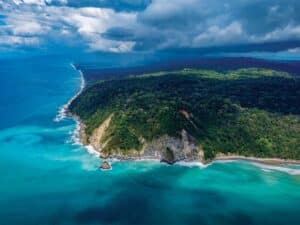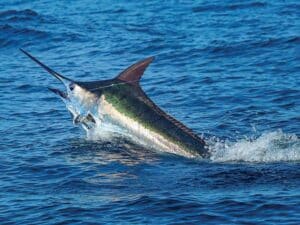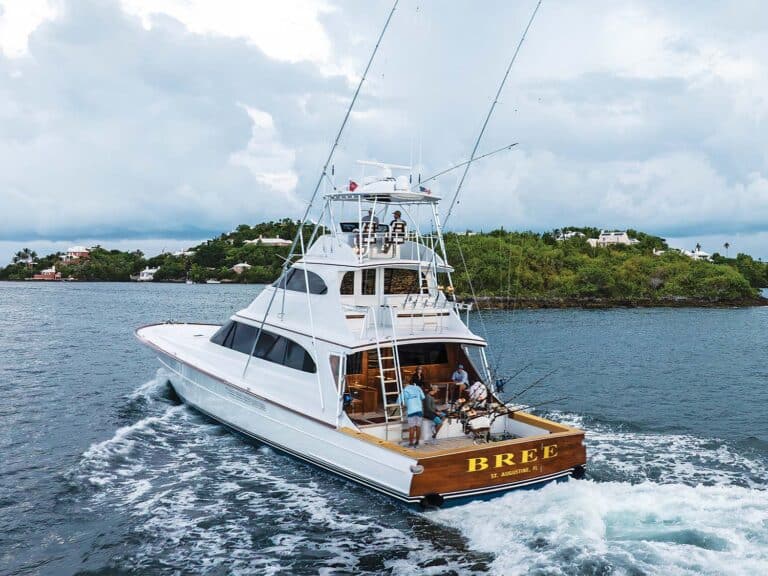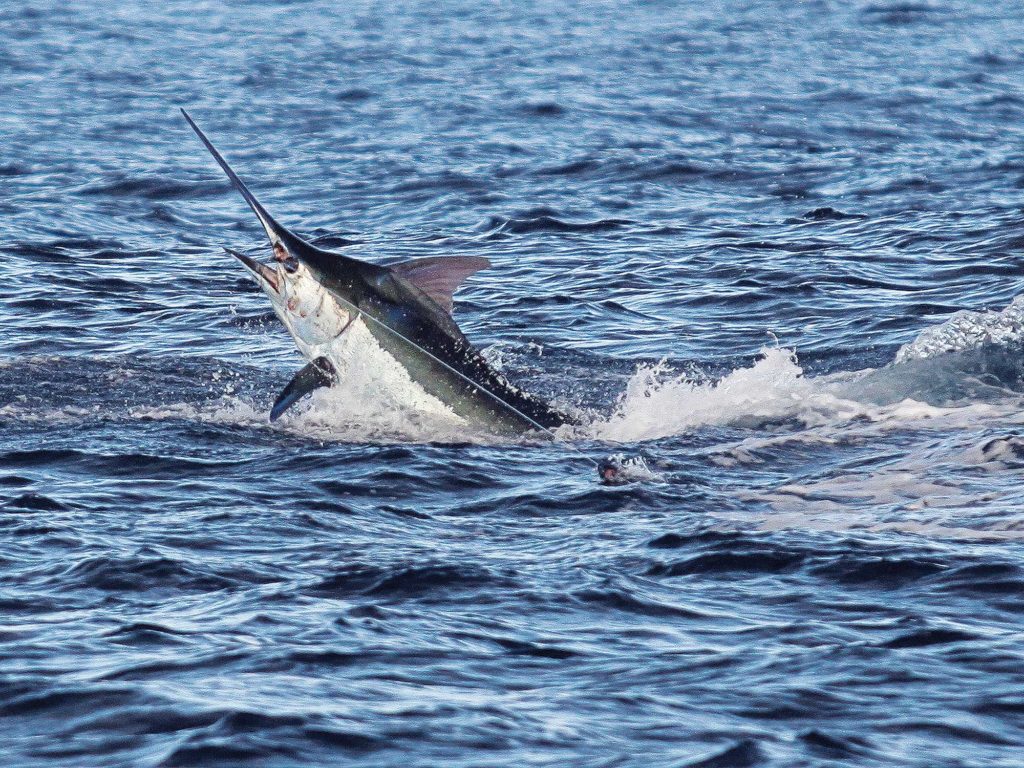
In the early 1600s, adventurous men took to the seas from their homelands in Europe, sailing across the Pacific Ocean—which encompasses more than 30 percent of the earth’s surface—in vessels with no charts and no knowledge of what to expect along the way. Unbeknownst to these early explorers, passing by the scattered islands and wave-enduring atolls that make up the Tuamotu island group was the fact that these natural treasures would remain the world’s most pristine oceanic islands and coral reefs for more than 300 years after their discovery.
In looking back at those early voyages, it doesn’t take much angler imagination to wonder what amazing schools of fish and how many huge marlin were passed over by those explorers. The largest marlin in the world—the blues and blacks of the central and South Pacific—were undiscovered until they became the quest of early fishing expeditions by visionaries such as Zane Gray. In 1928, Gray came to Tahiti and took his historic place in sport-fishing lore as the angler who caught the first 1,000-pound marlin, just offshore of this lush tropical paradise.
Inspired by my reading of these historic journeys and exploits, my lifelong ambition was to travel and explore the most virgin marlin waters in the world on my own quest, seeking an experience to emulate what those bold personalities faced so many decades ago.
A friend had suggested a world-class fishing operation of New Zealand heritage, which offered ultra-comfortable charter opportunities to one of the most remote atolls in the world: the Tuamotu Archipelago. The vessel is a state-of-the-art custom 91-foot twin-hulled sport-fisher of Kiwi design and construction, known as Ultimate Lady. A few email exchanges with Capt. Tom Francis had me even more convinced this trip would surpass my expectations as well as my imagination, more so than any other fishing trip I’d ever taken in my life.
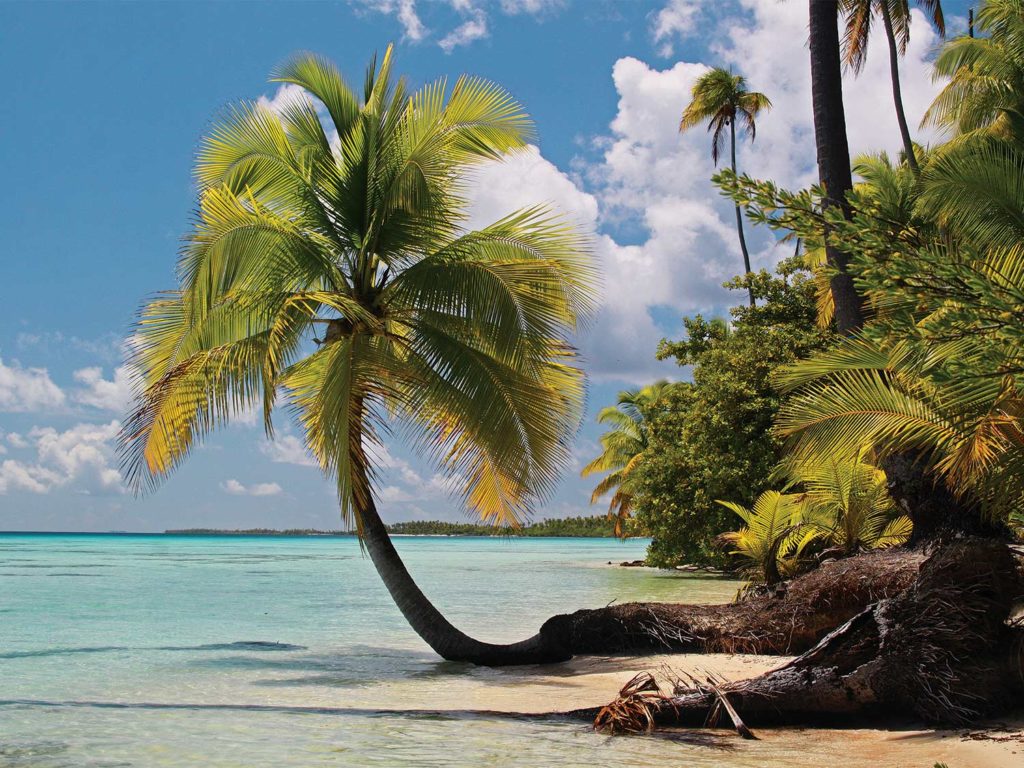
Getting There
Traveling to Tahiti is much easier now than it was 300 years ago, with at least 10 well-established airlines now offering flights from all corners of the world. But getting to Tahiti is only half the battle. An overnight stay, then a morning easterly flight is what really transfixes you into deep wonderment as you pass over a watery wilderness on the 500-mile flight from Tahiti to the Hao Atoll. The Tuamotu Archipelago is a long chain of 75 islands stretching eastward from Tahiti and covering an area of approximately 900 miles across the central South Pacific. Our trip began near the middle of this chain, where we planned to spend the next nine days traveling and fishing, heading west to the island of Fakarava. This 350-mile stretch of open ocean proved to be the most rewarding fishing trip anyone could possibly bless their lives with.
Flights to Tahiti
Airlines that service Tahiti include: Air Tahiti Nui; Air France; Hawaiian; American Airlines; Air New Zealand; LATAM Airlines; Quantas; Japan Air; and Delta. Once inside French Polynesia, the island-hopping flights are best served by Air Tahiti Nui.
In Tahiti, visitors usually spend a night in the town of Papeete before boarding the boat or following a charter. A tourist suggestion that is cultural, historical and fun to experience is the Tahitian dance show at the Intercontinental Hotel. Be sure to pair this with a dinner of local cuisine in the tropical outdoor setting. After all, you’re on vacation, so enjoy the ride.
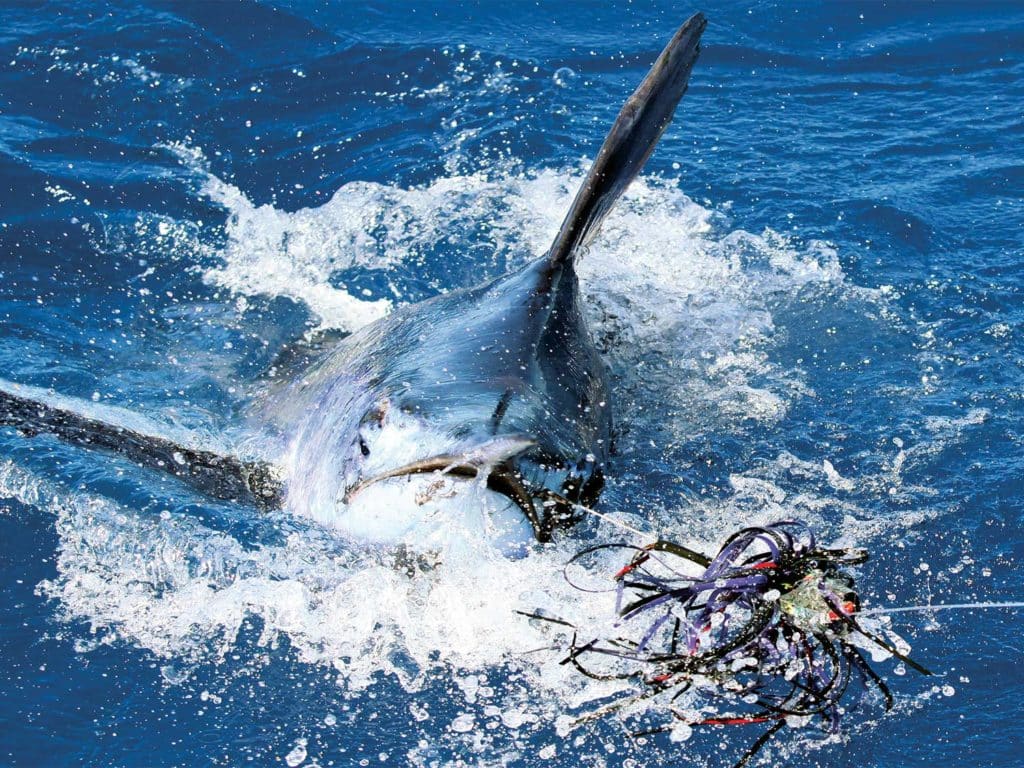
Fishing Opportunities
As expected in these atoll-strewn environments, the waters surrounding these undersea mountains get very deep, very quickly. The 100-fathom curve is typically just a few hundred yards from land and the 1,000-fathom curve is not much farther than a mile or so offshore. A rich soup of nutrients is created in the inner lagoons of these atolls, and the daily flushing tide helps push that nutrient load into the surrounding offshore waters. This in turn helps attract an abundance of pelagic fish that gleefully forage on the bait concentrations. Striped marlin are seasonal visitors to the Tuamotus but blue marlin are the most prevalent year-round billfish species. With an abundance of 200- to 600-pound blues constantly present in this part of the Pacific, it’s no surprise that ocean-surface ichthyoplankton studies in the area have discovered a high incidence of blue marlin larvae, suggesting these waters are active marlin spawning grounds.
The blue marlin we encountered were not picky eaters, either. Most came into the pattern with a ferocity which could have been triggered by a prespawn need for nourishment or possibly driven by their post-spawn aspirations of bulking up again for their next cycle of reproduction, something we couldn’t readily determine because we released all of our fish. Passing up the science angle, we took full advantage of the technology on the boat to find the local blue marlin density. The instrument most beneficial to consistently finding blue marlin in our fishing zone was the amazing MAQ side-scanning sonar, which in these seas and conditions was able to pick up billfish targets up to 950 yards—or about a half-mile away. So even though we didn’t draw all these fish into our spread, we knew they were there.
We targeted blue marlin for roughly three days of our trip—raising 17 fish, releasing 11. Most averaged a respectable 300 pounds, kept fat and sassy with the prolific populations of oceanic skipjack and small yellowfin tuna that are found in abundance near these atolls. For a 91-foot sport-fisher, Ultimate Lady gets bit really well because of the extremely clean wake she leaves, with widely visible channels between her dual hull configuration. Matching this hull with the efficiency of her custom five-bladed carbon-fiber props produces minimal prop wash—truly an impressive boat to marlin fish from.
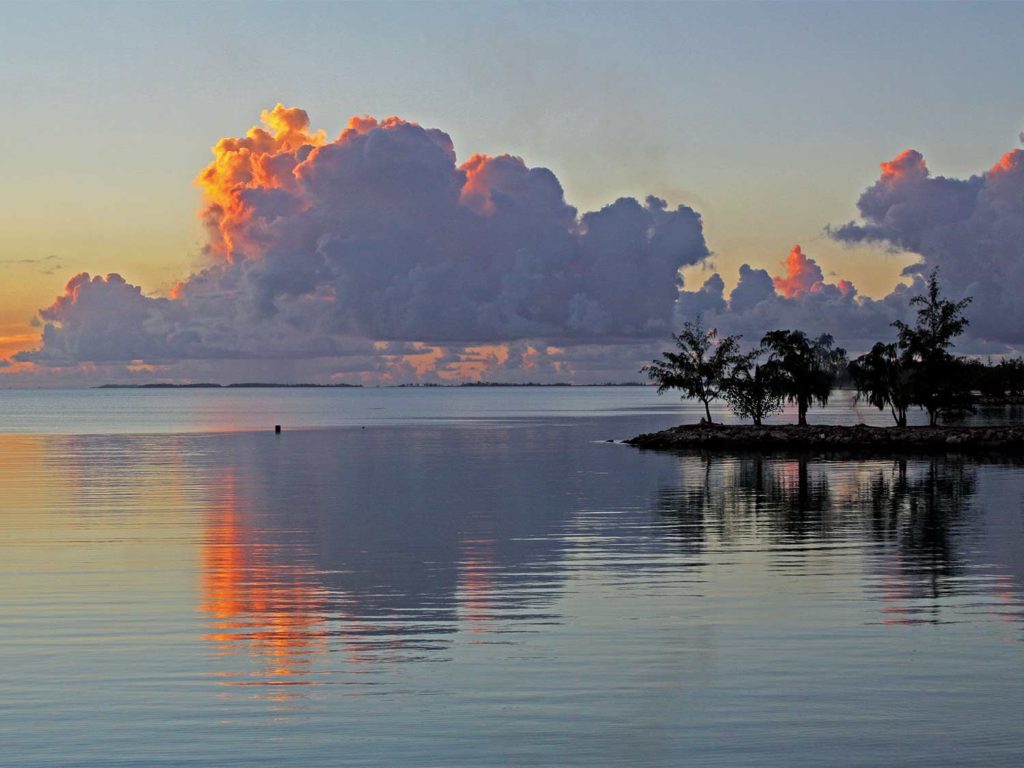
Francis has run Ultimate Lady for nearly 20 years and has been all over the Pacific Ocean with the boat. From the Marquesas Islands in the central eastern Pacific to the entire length of the Great Barrier Reef on the western edge of the South Pacific, it is in the Tuamotus that he smiles most when talking about blue marlin fishing. His fishing logs and experience speak volumes, but he told me in a recent conversation, “very experienced international freediving spear fishermen tell me they see many more blue marlin while targeting tuna and wahoo in the Tuamotus than any other places they have dove.” Interesting.
When asked about his spots, he says, “I like the waters at the northern end of Rangiroa, and around the perimeter of the Hao atoll, as well as the areas near the island of Tahanea.” Francis has yet to fish is the northeast Tuamotus at Takaroa, where the nutrient-rich equatorial current flows southerly and graces the region with boastful bounty, yet he feels this may offer excellent action as well.
Another area of the Tuamotus where Ultimate Lady travels to is in the Gambier Islands. Resting at the southeastern most edge of the Tuamotu Archipelago, these islands offer a wide range of offshore banks and structure that Francis relates as being angling nirvana. A variety of gamefish reach exceptional sizes; blue and black marlin mix with bigeye, yellowfin, and dogtooth tuna, and the wahoo, giant trevally and inshore species are prolific as well. Three Air Tahiti Nui flights a week reach the Gambiers, making it accessible without a long boat ride.
Fishing Techniques
Diligent trolling efforts, covering a wide area while glassing for birds—and keeping a watchful eye on the sonar—serves as the best way to locate marlin in this habitat. If small tuna schools are working an area and Francis is marking worthy marlin targets below them or in their general vicinity, then he’ll make use of the numerous tuna tubes on the vessel and begin live-baiting, which often proves a perfect remedy for these roving marlin. Ultimate Lady spends plenty of time on the Great Barrier Reef and was designed with tuna tubes that can accommodate a 30-pound yellowfin. Knowing that many skippers in the South Pacific feel confident fishing larger live-bait sizes up to a 10-to-1 fish-to-bait ratio, even a 30-pounder is just a snack for most marlin in these waters.
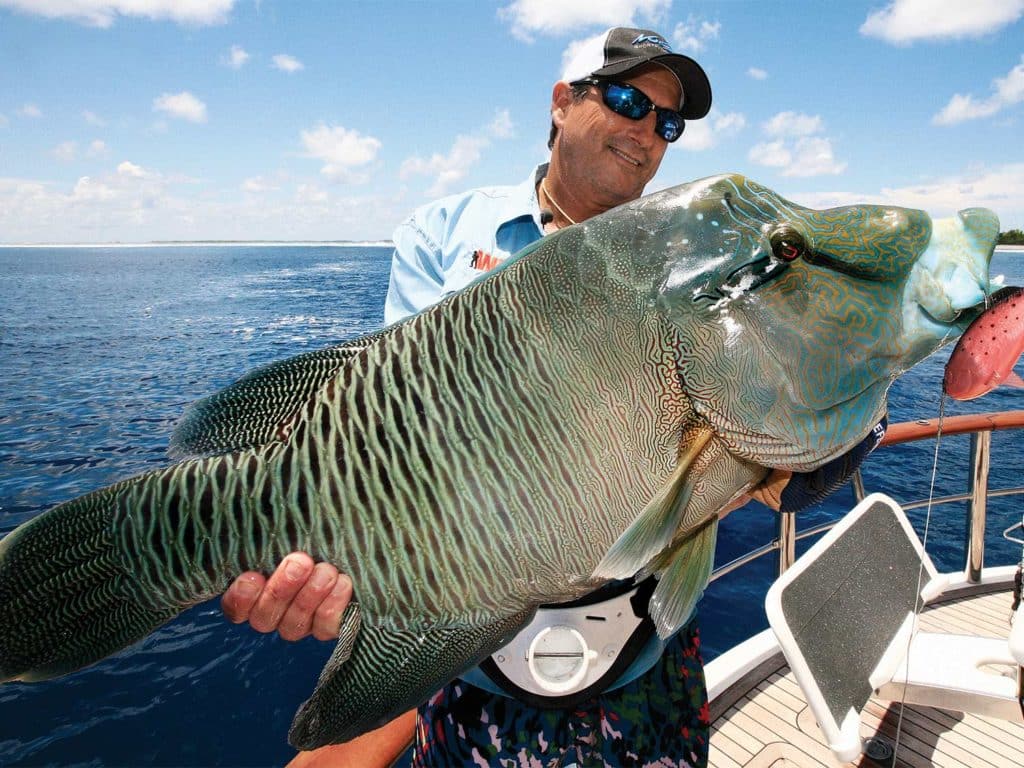
Other Species to Target
The pristine reef conditions of the Tuamotus are home to a multitude of other gamefish that can be memorable catches for those who might never have another angling opportunity like this. The dogtooth tuna is certainly one of those species. Not only are “doggies” equipped with dinosaur-like teeth, they also have the ability to fight and pull hard at any depth. These tuna can be caught on the surface around inlets and oceanic structure, but the biggest come while deep jigging along vertical walls and deep banks. Not being too selective in what they will eat, chrome or painted butterfly jigs with dangle-hook setups work best for these beasts. Best to consider a wire leader—you will need it.
Huge wahoo are also prevalent throughout the islands and fish surpassing 70 pounds are common. Trolling Halco Giant Tremblers and Maxx 190s and 220s were deadly for these fish. Don’t be surprised when a triple-digit yellowfin or bigeye tuna jumps on those very same lures, because these waters are big tuna grounds as well.
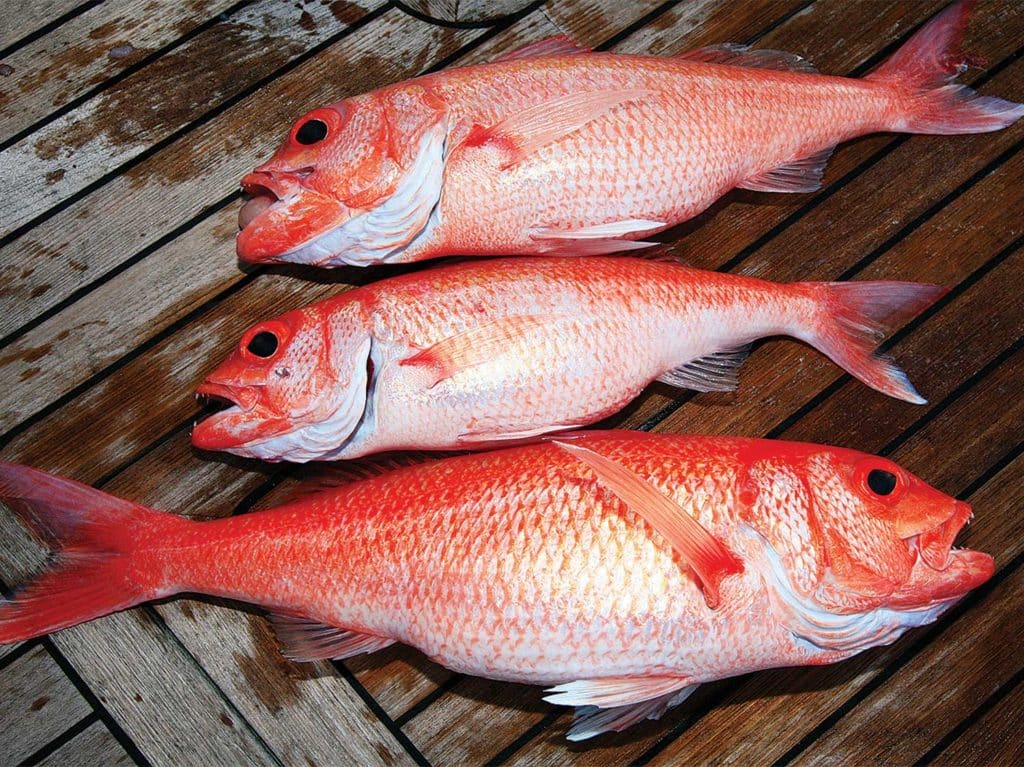
Best Times to Fish
Blue marlin are a year-round species but June through September is historically the best time for the most consistent bite. Striped marlin are quite common in August and September, where a good day can garner a few bites from fish in the 150- to 200-pound range. Much like New Zealand, striped marlin up to 300 pounds can also be encountered here during the season.
As a point of interest, black marlin are not that prevalent. Sizable blacks in the 600- to 800-pound range have been caught in the Gambiers but for some reason are not often hooked in the rest of the Tuamotu islands.
The tunas are another year-round fishery, with January through March considered best for the yellowfin, while bigeye and dogtooth tunas are consistently caught year-round when you are fortunate enough to encounter them on the surface, or brave enough to deep jig for them. I say brave enough because jigging can be hard work and when you hook up a big doggie, you should be prepared for a long and arduous battle.
What I Brought Home
I’ve made two fishing trips aboard Ultimate Lady now, one in the Austral Islands south of Tahiti and the other in the Tuamotu islands. Both are to this day the most memorable fishing trips of my life. It’s not just the fishing but also the adventure of fishing virgin habitats that are seen and experienced by only a handful of anglers. Passing countless atolls over several days and camping out in their inner waters while being greeted by world-class sunsets captivate your soul as you reflect on being in the presence of such remote wilderness, where history has been forged but time has seemingly forgotten.
Doing this all in the comfort and class of one of the most technologically-advanced sport-fishers in the world, with a crew of dedicated, consummate professionals who make it their pleasure to provide you with great service and angling advice—all the while showing off their culinary skills—is a memory that will make you smile ear to ear until your last days.
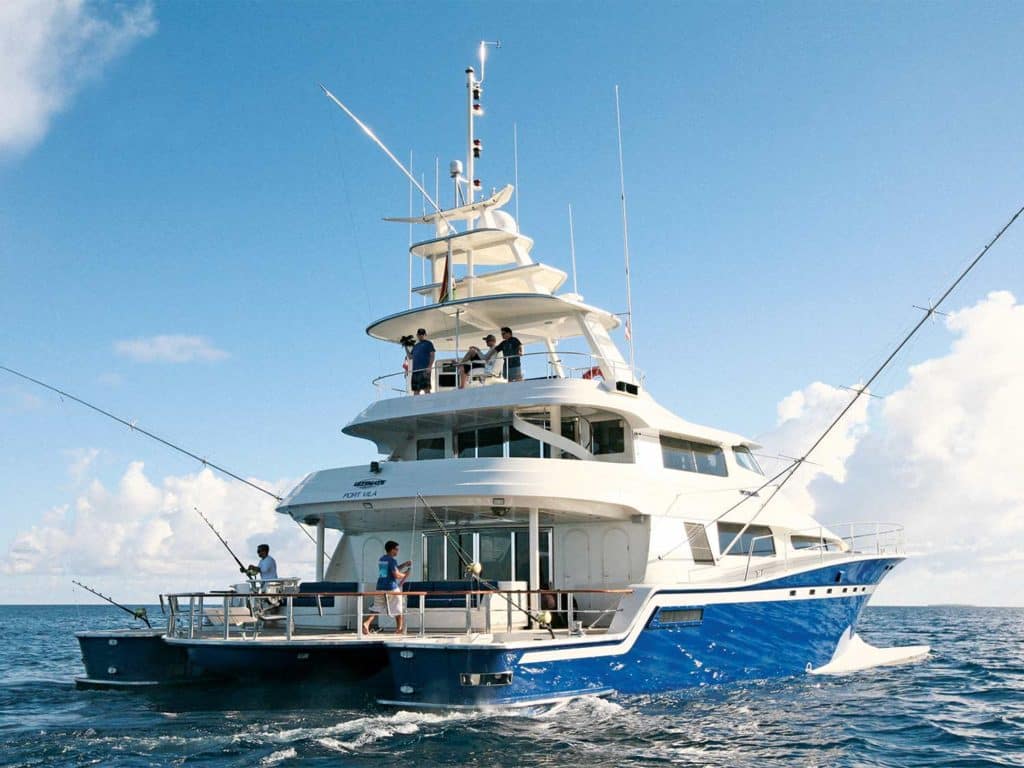
Ultimate Lady
Designed by Craig Loomes of LOMOcean Naval Architecture and Yacht Design and built in 1998, Ultimate Lady was well ahead of her time. Thinking way outside the box and constructing the dream of owner Fred Lewis, the twin-hull design has wave-piercing extensions on each bow. The boat sits high above the waterline, allowing small chop to pass beneath the belly with minimal hull interaction. Powered by twin MAN diesels, Ultimate Lady burns only 8.5 gallons per hour at 8 knots. At a 20-knot cruise, the fuel burn is a respectable 50 gallons per hour.
With massive marlin doors on both sides of the stern and a large, extendable fighting chair that can swivel an amazing radius of the cockpit, these features combine to make this an extremely fishy boat for its size and beam.
There are accommodations for eight guests in five staterooms, with crew quarters for an additional five. Ultimate Lady charters all over the Society Islands north of Tahiti, including Bora Bora, Moorea and points north. For more information, visit ultimatelady.com.

